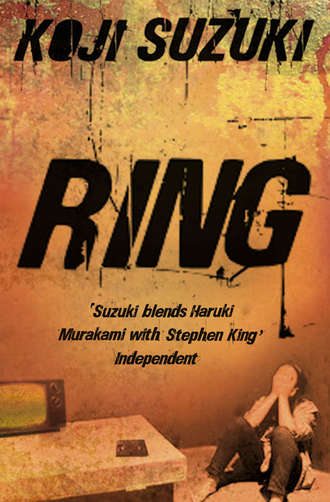
Полная версия
The Complete Ring Trilogy: Ring, Spiral, Loop
Sadako had stayed in the rehearsal hall alone after everyone else had left, so that she could test her powers on the television set, still a rarity in those days. She was trying to be careful not to let anyone know what she could do.
“Who’s the old woman who appears in the next scene?” asked Asakawa.
“I don’t know who that is. Perhaps she came to Sadako in a dream or something, whispered prophecies in her ear. She was using an old dialect. I’m sure you’ve noticed that everyone here now speaks fairly standard Japanese. That lady was pretty old. Maybe she lived in the twelfth century, or maybe she has some connection to En no Ozunu.”
… Next year you’re going to have a child.
“I wonder if that prediction really came true?”
“Oh, that? Well, there’s the scene with the baby boy right after that. So I originally thought it meant that Sadako had given birth to a boy, but according to this fax, that doesn’t appear to be the case.”
“There’s her brother who died at four months old …”
“Right. I think that’s it.”
“But what about the prediction? The old woman is definitely speaking to Sadako—she says you. Did Sadako have a baby?”
“I don’t know. If we believe the old lady, then I guess she did.”
“Whose child was it?”
“How should I know? Listen, don’t think I know everything. I’m just speculating here.”
If Sadako Yamamura did have a child, who was the father? And what was the child doing now?
Ryuji stood up suddenly, banging his knees on the table as a result.
“I thought I was getting hungry. Look—it’s way past noon. Say, Asakawa, I’m going to get something to eat.” So saying, Ryuji headed for the door, rubbing his kneecaps. Asakawa had no appetite, but something still bothered him, and he decided to tag along. He’d just remembered something Ryuji had told him to investigate, something he’d had no clue how to approach and so hadn’t done anything about. This was the question of the identity of the man in the video’s last scene. It might be Sadako’s father, Heihachiro Ikuma, but there was too much enmity in the way Sadako looked at him for that. When he’d seen the man’s face on the screen, Asakawa had felt a dull, heavy pain somewhere deep inside his body, accompanied by a strong feeling of antipathy. He was a rather handsome man, particularly around the eyes; he wondered why she hated him so. No matter what, that kind of gaze was not one Sadako would have turned on a relative. There was nothing in Yoshino’s report to suggest that she had squared off against her father. Rather, he got the impression that she was close to her parents. Asakawa suspected it would be impossible to discover the identity of this man. Nearly thirty years had undoubtedly changed his looks considerably. Still, just on the off-chance, maybe he should ask Yoshino to dig up a photo of Ikuma. He wondered what Ryuji would think about this. Wanting to take the matter up with him, Asakawa followed Ryuji outside.
The wind blew loudly. There was no point in using an umbrella. Asakawa and Ryuji hunched their shoulders and ran down the street to a bar in front of the harbor.
“How about a beer?” Without waiting for a reply, Ryuji turned to the waitress and called out, “Two beers.”
“Ryuji, to go back to our earlier conversation, what do you think the images on that video are, finally?”
“Don’t know.”
Ryuji was too busy eating his Korean barbecue lunch special to even look up, so he gave a curt answer. Asakawa stabbed a sausage with his fork and took a swallow of his beer. Out the window they could see the pier. There was nobody at the ticket window for the Tokai Kisen ferry line. Everything was silent. No doubt all the tourists trapped on the island were sitting at the windows of their hotels or B&Bs, looking worriedly at this same dark sea and sky.
Ryuji looked up. “I imagine you’ve probably heard what people say goes though a person’s mind at the moment of death, right?”
Asakawa returned his gaze to the scene in front of him. “The scenes from your life that have made the deepest impression on you are replayed, sort of like a flashback.” Asakawa had read a book in which the author described an experience along those lines. The author had been driving his car along a mountain road when he lost control of the steering wheel, plunging the car into a deep ravine. During the split second that the car hung in the air after leaving the road, the author realized that he was going to die. And at the instant he realized that, a sequence of different scenes from throughout his life came pitter-pattering up and flashed through his brain, so clearly that he could see every detail. In the end, miraculously, the writer had survived, but the memory of that instant remained vivid for him.
“You can’t be suggesting … Is that what this is?” Asakawa asked. Ryuji raised a hand and signaled the waitress to bring him another beer.
“All I’m saying is, that’s what the video reminds me of. Each one of those scenes represents a moment of extreme psychic or emotional engagement for Sadako. It’s not too much of a stretch to think that they were the scenes in her life that left the deepest impression, is it?”
“I get it. But hey, does that mean that …”
“Right. There’s a strong possibility that that’s the case.”
So Sadako Yamamura is no longer of this world? She died, and the scenes which flitted through her mind at the moment of death had taken this shape and remained in the world of the living—was that it?
“So why did she die? And another thing, what was her relationship with the man in the last scene of the video?”
“I told you to stop asking me so many questions. There’s a lot I don’t understand about it, either.”
Asakawa looked unconvinced.
“Hey, try using your head for a change. You rely too much on other people. What would you do if something happened to me and you were stuck trying to figure out the charm all by yourself?”
That hardly seemed likely. Asakawa might die, and Ryuji might solve the riddle alone, but the opposite would never happen. Asakawa was sure of that, if of nothing else.
They went back to the “bureau” where Hayatsu was waiting for them. “You had a call from a fellow named Yoshino. He wasn’t at his office, so he said he’d call back in ten minutes.”
Asakawa sat in front of the phone and prayed for good news. The phone rang. It was Yoshino.
“I’ve been trying to call you. Where were you?” There was a note of reproach in his voice.
“Sorry about that. We went out to get a bite to eat.”
“Okay. Now, did you get my fax?” Yoshino’s tone changed. The note of criticism disappeared, and his voice became gentler. Asakawa felt something unpleasant coming.
“Yes, thanks. It was very helpful.” Asakawa switched the receiver from his left hand to his right. “And, so? Did you find out what happened to Sadako after that?” Asakawa asked enthusiastically.
There was a pause before Yoshino replied, however. “No. I hit a dead end.”
The second he heard this, Asakawa’s face crumpled as if he were about to burst into sobs. Ryuji watched as if he found it amusing to see a man’s expression turn from hope to despair before his eyes. Then he plopped himself down on the floor facing the garden and stretched his legs out in front of him.
“What do you mean, a dead end?” Asakawa’s voice had risen several notes.
“I was only able to locate four of the interns who joined the troupe with Sadako. I called them, but none of them know anything. They’re all middle-aged guys of around fifty now. All any of them could tell me was they hadn’t seen her since shortly after the death of Shigemori, the company’s representative. There’s no more information to be had about Sadako Yamamura.”
“Nonsense. This can’t be the end of it.”
“Well, how does it look on your end?”
“How does it look on my end? I’ll tell you how it looks. It looks like I’m going to die tomorrow night at ten o’clock. And not just me—my wife and daughter are going to die on Sunday morning at eleven. That’s how it looks.”
Ryuji called out from behind him, “Hey, don’t forget about me! You’ll make me feel bad.”
Asakawa ignored him and continued. “There’ve got to be other things you can try. Maybe there’s someone besides the interns who would know what happened to Sadako. Listen, my family’s lives depend on it.”
“Not necessarily, though.”
“What are you talking about?”
“Maybe you’ll still be alive after the deadline passes.”
“You don’t believe me. I get it.” Asakawa could feel the whole world go dark before his eyes.
“Well … I mean, how could I really believe a hundred percent in a story like this?”
“Now, look, Yoshino.” How should he put it? What did he need to say to convince him? “I don’t even believe the half of it myself. It’s stupid. A charm? Come on! But you see, if there’s even a one-in-six chance that it’s all true … It’s like Russian roulette. You’ve got a gun with one bullet in it, and you know that there’s only one chance in six that when you pull the trigger it’ll kill you. But could you pull that trigger? Would you risk your family on those odds? No, you wouldn’t. You’d move the muzzle away from your temple—if you could you’d throw the whole damned gun into the ocean. Right? It’s only natural.”
Asakawa was all wound up now. Behind him Ryuji was wailing, “We’re idiots! Both of us, idiots!”
“Shut up!” Asakawa shielded the receiver with the palm of his hand as he turned to yell at Ryuji.
“Something wrong?” Yoshino lowered the tone of his voice.
“No, it’s nothing. Listen, Yoshino, I’m begging you. You’re the only one I can count on.” Suddenly Ryuji grabbed Asakawa’s arm. Giving way to anger, Asakawa spun around, but when he did he saw that Ryuji was looking unexpectedly earnest.
“We’re idiots. You and I both have lost our cool,” he said, quietly.
“Could you hold on a minute?” Asakawa lowered the receiver. Then, to Ryuji, “What’s the matter?”
“It’s so simple. Why didn’t we think of it before? There’s no need to follow Sadako’s trail chronologically. Why can’t we work our way backwards? Why did it have to be cabin B-4? Why did it have to be Villa Log Cabin? Why did it have to be South Hakone Pacific Land?”
Asakawa’s expression changed in a heartbeat as he came to a realization. Then, in a much calmer mood, he picked up the receiver again.
“Yoshino?”
Yoshino was still waiting on the other end of the line.
“Yoshino, forget about the theater company lead for a while. There’s something else I urgently need you to check on. It’s just come up. I believe I’ve already told you about South Hakone Pacific Land …”
“Yeah, you did. It’s a resort club, right?”
“Right. As I recall, they built a golf course there about ten years ago, and then gradually expanded into what they are now. Now, listen, what I need you to look up is, what was there before Pacific Land?”
He could hear the scratching of pen on paper.
“What do you mean, what was there before? Probably nothing but mountain meadows.”
“You may be right. But then again, you may be wrong.”
Ryuji tugged at Asakawa’s sleeve again. “And a layout. If there was something standing on that land before the resort, tell your gentleman caller to get a map that shows the layout of the buildings and the grounds.”
Asakawa relayed the request to Yoshino and hung up the phone, willing him to come up with something, anything, by way of a lead. It was true: everybody had a little psychic power.
10
October 18—Thursday
The wind was a little stronger, and low white clouds raced by in the otherwise clear sky. Typhoon No. 21 had passed by the previous evening, grazing the Boso Peninsula to the northeast of Oshima before dissipating over the ocean. In its wake it left painfully dazzling blue seas. In spite of the peaceful autumn weather, as Asakawa stood on the deck of the boat watching the waves he felt like a condemned man on the eve of his execution. Raising his eyes he could see the gentle slope of the Izu highlands in the middle distance. Today, at last, he would face his deadline. It was now ten in the morning; in another twelve hours, it would come, unerringly. It had been a week since he watched the video in cabin B-4. It seemed like ages ago. Of course it felt like a long time: in just one week he’d experienced more terror than most people experience in a lifetime.
Asakawa wasn’t sure now that being cooped up on Oshima all day Wednesday had hurt him. On the phone yesterday he’d got excited and accused Yoshino of dragging his feet, but now that he thought about things calmly, he was actually very grateful to his colleague for doing so much for him. If Asakawa had been running around chasing down leads himself, he probably would have got agitated and missed something, or gone down a blind alley.
This is fine. The typhoon was on our side. If he didn’t think that way, he’d never make it. Asakawa was starting to prepare his mind so that when his time came to die he wouldn’t be consumed with regrets about what he had or hadn’t done.
Their last clue was the three-page printout he held in his hand. Yoshino had spent half the previous day tracking down the information before faxing it. Before South Hakone Pacific Land had been built, the land had been occupied by a rather unusual facility. Unusual these days, that is—at the time, establishments like it were perfectly run-of-the-mill. It was a tuberculosis treatment facility—a sanatorium.
Nowadays few people lived in fear of TB, but if one read much prewar fiction, one couldn’t help but come across mention of it. It was the tuberculosis bacillus that gave Thomas Mann the impetus to write The Magic Mountain, that allowed Motojiro Kajii to sing with piercing clarity of his decay. However, the discovery of streptomycin in 1944, and hydrazide in 1950, stole TB’s literary cachet, reducing its status to that of just another communicable disease. In the ’20s and ’30s, as many as 200,000 people a year were dying from it, but the number dropped drastically after the war. Even so, the bacillus didn’t become extinct. Even now, it still kills around five thousand people a year.
In the days when TB ran rampant, clean, fresh air and a quiet, peaceful environment were deemed essential for recovery. Thus, sanatoriums were built in mountainous areas. But as progress in medicinal treatments produced a corresponding drop in the number of patients, these facilities had to adjust their range of services. In other words, they had to start treating internal ailments, even performing surgeries, or else they wouldn’t be able to survive financially. In the mid-1960s, the sanatorium in South Hakone was faced with just this choice. But its situation was even more critical than most, due to its extreme remoteness. It was just too hard to get to. With TB, once patients checked in they usually didn’t check back out again, so ease of access wasn’t much of an issue. But it proved to be a fatal flaw in the plan to transform the place into a general hospital. The sanatorium ended up shutting down in 1972.
Waiting in the wings was Pacific Resorts, which had been looking for a suitable location to build a golf course and resort. In 1975, Pacific Resorts bought a section of alpine land which included the old sanatorium site and immediately set about developing their golf course. Later they built summer homes to sell, a hotel, a swimming pool, an athletic club, and tennis courts—the whole line of resort facilities. And in April of this year, six months ago, they’d put the finishing touches to Villa Log Cabin.
“What kind of place is it, then?” Ryuji was supposed to be on deck, but he suddenly appeared in the seat next to Asakawa.
“Huh?”
“South Hakone Pacific Land, of course.”
That’s right. He’s never been there.
“It’s got a nice view at night.” Asakawa recalled the curiously lifeless atmosphere, the tennis balls with their hollow echo under the orange lights … Where does that atmosphere come from anyway? I wonder how many people died there when it was a sanatorium. Asakawa pondered this as he remembered how the beautiful evening lights of Numazu and Mishima had spread out at his feet.
Asakawa put the first page of the printout on the bottom and spread the other two pages out on his lap. The second page was a simple diagram showing the layout of the sanatorium grounds; the third showed the building as it was today, an elegant three-story building containing an information center and a restaurant. This was the building Asakawa had entered to ask directions to Villa Log Cabin. Asakawa shifted his gaze back and forth between the two pages. The passage of nearly thirty years was embodied in those two pieces of paper. If it wasn’t for the fact that the access road was in the same place, he’d have no idea what on one map corresponded to what on the other. Mentally reconstructing the layout as he knew it, he looked at the second page to try to find out what had originally stood where the cabins were now. He couldn’t be absolutely sure, but when he lay one page on top of the other, it certainly seemed as if there had been nothing there before. Just thick woods covering the side of a valley.
He went back to the first page. It contained one more very important piece of information, besides the story of the sanatorium’s transformation into a resort. Jotaro Nagao, 57. A doctor, a GP and pediatrician, with a private practice in Atami. For five years, from 1962 to 1967, Nagao had worked at the South Hakone sanatorium. He’d been young, just past his internship. Of the doctors who’d been there at the time, the only ones still alive were Nagao and Yozo Tanaka, who was retired now, living with his daughter and her husband in Nagasaki. All the rest, including the head of the facility, were dead. Therefore, Dr Nagao was their only chance to find out anything about the sanatorium in South Hakone. Yozo Tanaka was already 80, and Nagasaki was much too far away—they wouldn’t have time to visit him.
Asakawa had pleaded desperately with Yoshino to find a living witness, and Yoshino, gritting his teeth to keep from yelling back at Asakawa, had come up with Dr Nagao. He’d sent not only the man’s name and address, but also an intriguing summary of his career. It was probably just something Yoshino had happened to come across in his research, and he’d decided to append it, not actually meaning anything by it. Dr Nagao had been at the sanatorium from 1962 to 1967, but he hadn’t spent the entirety of those five years in the performance of his duties. For two weeks—a short time, to be sure, but significant—he’d gone from doctor to patient, and been housed in an isolation ward. In the summer of 1966, while visiting an isolation ward up in the mountains, he’d carelessly allowed himself to contract the smallpox virus from a patient. Fortunately, he had been inoculated a few years previously, so it didn’t turn into anything major: no visible outbreak, no recurrence of the fever, only minor symptoms. But they’d put him in isolation to keep him from infecting anyone else. What was so interesting was that this had assured Nagao a place in medical history. He had been the last smallpox patient in Japan. It wasn’t necessarily something that would get him into the Guinness Book, but Yoshino seemed to have thought it was interesting. For people of Asakawa and Ryuji’s generation, the word “smallpox” didn’t even register.
“Ryuji, have you ever had smallpox?”
“Idiot. Of course not. It’s extinct.”
“Extinct?”
“Yes. Eradicated through human ingenuity. Smallpox no longer exists in this world.”
The World Health Organization had made a dedicated effort to wipe out smallpox through vaccinations, and as a result it had all but disappeared from the face of the earth by 1975. There are records of the last smallpox patient in the world: a Somalian youth who came down with it on October 26, 1977.
“Can a virus become extinct? Is that possible?” Asakawa didn’t know much about viruses, but he couldn’t shake the impression that no matter how much you tried to kill one, eventually it would mutate and find a way to survive.
“See, viruses kind of wander around on the border between living things and non-living things. Some people even theorize that they were originally human genes, but nobody really knows where they come from or how they emerged. What’s certain is that they’ve been intimately connected with the appearance and evolution of life.”
Ryuji’s arms had been folded behind his head; now he stretched them wide. His eyes glittered. “Don’t you find it fascinating, Asakawa? The idea that genes could escape from our cells and become another life form? Maybe all opposites were originally identical. Even light and darkness—before the Big Bang they were living together in peace, with no contradiction. God and the Devil, too. All the Devil is is a god who fell from grace—they’re the same thing, originally. Male and female? It used to be that all living things were hermaphroditic, like worms or slugs, with both female and male sex organs. Don’t you think that’s the ultimate symbol of power and beauty?” Ryuji laughed as he said this. “It’d sure save a lot of time and trouble when it comes to sex.”
Asakawa peered at Ryuji’s face to see what was so funny. There was no way that an organism with both female and male genitalia epitomized perfect beauty.
“Are there any other extinct viruses?”
“Gee, if you’re so interested I suggest you look right into it when you get back to Tokyo.”
“If I get back.”
“Heh, heh. Don’t worry. You’ll get back.”
At that moment the high-speed boat they were on was exactly halfway through the voyage linking Oshima and Ito, on the Izu Peninsula. They could have made it back to Tokyo quicker by flying, but they wanted to visit Dr Nagao in Atami, so they’d taken the sea route.
Straight ahead they could see the ferris wheel at the Atami Korakuen. They were arriving right on time, at 10:50. Asakawa descended the gangway and ran to the parking lot where they’d left their rental car.
“Calm down, would you?” Ryuji followed at a leisurely pace. Nagao’s clinic was near Kinomiya Station on the Ito Line—not very far away at all. Asakawa watched impatiently as Ryuji climbed into the car, and then headed into Atami’s maze of hills and one-way streets.
Immediately after he’d settled himself, Ryuji said, with a perfectly straight face, “Hey, I was thinking—maybe the Devil’s behind this whole thing after all.” Asakawa was too busy looking at street signs to answer. Ryuji continued. “The Devil always appears in the world in a different form. You know the bubonic plague that ravaged Europe in the second half of the thirteenth century? Half of the total population died. Can you believe that? Half, that’s like the population of Japan being reduced to sixty million. Naturally, artists at the time likened the plague to the Devil. It’s like that now, too—don’t we talk about AIDS as if it were a modern Devil? But listen, devils never drive humanity to extinction. Why? Because if people cease to exist, so do devils. The same with viruses. If the host cell perishes, the virus can’t survive. But humanity drove the smallpox virus to extinction. Really? Could we really do that?”
It’s impossible in the modern world to even imagine the terror once inspired by smallpox, when it raged throughout the world claiming so many lives. Such was the suffering it caused that it gave rise to innumerable religious beliefs and superstitions in Japan, as well as elsewhere. People believed in gods of pestilence, and it was the God of Smallpox that brought that disease, though perhaps it should have been called a devil. In any case, could people really drive a god to the brink of extinction? Ryuji’s question harbored a deep uncertainty.
Asakawa wasn’t listening to Ryuji. In some corner of his mind he wondered why the guy was rambling on about this now, but mainly he was just thinking about not making any wrong turns. Every nerve focussed on getting to Dr Nagao’s clinic as fast as possible.








